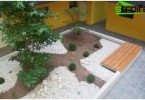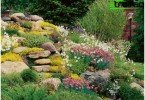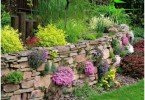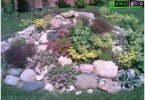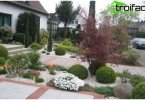The main purpose of the personal plot, each owner sees in his own way. For some, this is a place of solitude and relaxation, for some, the opportunity to noisily rest in the company of friends, without causing an angry reaction from neighbors, someone perceives garden squares exclusively as a subsidiary farm, and for some this is a field for creativity. Combining such approaches is quite difficult, especially if the area of the site is very limited, but possible. A hedge of hawthorn or hawthorn will replace wooden fences and hide technical buildings without taking up extra space, while refining and decorating the landscape.
Content
- The benefits of green walls
- Requirements for the used plants
- Design Methods: to cut or not to cut
- Green wall care
The benefits of green walls
Exactly trimmed lawns, a perfectly delineated line of trimmed bushes and the monotonous clicking of garden scissors is a typical movie picture with a plot unfolding on the outskirts of London. The fashion for decorating trees and shrubs came precisely from England, where you can hardly find a suburban mansion that does not surround a hedge of barberry or rose hip. The fences created by nature and slightly corrected by the human hand are presented here in all their diversity: high, designed to completely hide from the curious the space around the estate; medium, conditionally dividing the park area into sectors, and low, performing the function of small borders. The noble grooming of such a fence sets the tone for the entire garden.
At the same time, this method of fencing sites is common not only in elite areas. Willow hedges are the most popular fence even in European farms. Cattle pastures were fenced with landings both for practical reasons and under the influence of superstitions, attributing to the green walls also the role of the habitat of the guard elves. It was believed that tightly tangled branches were an ideal shelter for spirits and gnomes, ensuring the safety of livestock and crop plantings.
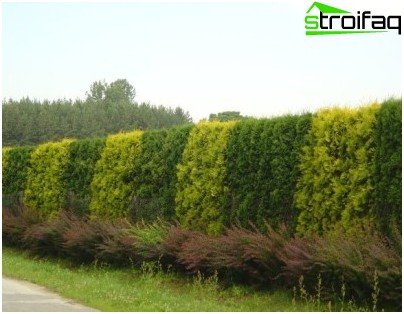
Hedgerow – the possibility of unlimited play with color and shapes
There are more practical reasons for spreading living fences in the modern world. Hedgerows are durable and unpretentious, they look decorative and do not require large investments, they provide a dense curtain not only from sunlight, but also from road dust and noise, refreshing the air.
Requirements for the used plants
The desired height of the living fence is a determining factor in choosing the type of plant. The maximum height achieved by the plant should be considered first. A hawthorn hedge is not able to close the wall of a high shed, and it is not customary to cut the height of the spruce hedge, since its upper edge will not be even. Different types of plants are used for different types of natural walls..
Low curb plantings are made up of mountain pug Pug, stunted spindle tree, dwarf jasmine, magnolia, Erica and western thuja. Boxwoods related to year-round green plants are also well suited for this purpose. With little snowfall in a particular region, they decorate the garden in the cold season.
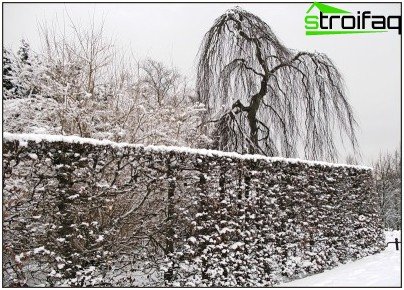
Deciduous hedges become almost transparent in winter
A hedge of barberry or dogrose is on average limited to a height of 1–1.5 meters. Fences of medium height are the most common in Russia, they are so easy to care for and diverse, thanks to a large assortment of shrubs that easily tolerate the difficult climate. Medium sized living garden partitions can combine the functions of a fence and a fruit tree.
In addition to the most common virigins, dogwood, viburnum, cherries and currants, hazels can also be called. Not only beautifully blooming in the spring, but also bringing practical benefits. Also the hedge of lilac, mock orange, hydrangea belongs to the middle ones. If you want to turn the green fence into an impregnable barrier along the site, you can plant a hawthorn, climbing rose or dog rose, which are not only dense, but also prickly.
The high walls of trees, called trellises, are not limited in height. Landing above 2 meters is customary to include them. Often this role is played by maples, broadleaf linden and hornbeam, and from conifers – various varieties of spruce. Juniper as an evergreen plant is also often used to create tall hedges, the thuja hedge differs by this feature.
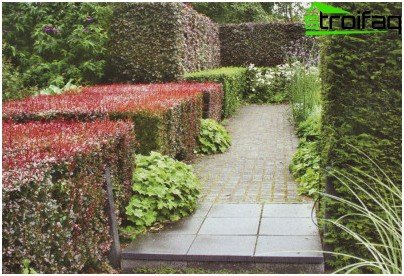
The combination of hedges of various heights creates an original and functional landscape ensemble.
The choice of vegetation for a living wall must be approached carefully: the landing will take its final form only after a few years, and any misses are a waste of time and invested effort. The vegetation should have dense foliage with a long growing season, get along well with neighboring plantings, match the climatic features of the region and soils.
Design Methods: to cut or not to cut
The beauty of a living fence in its clear forms, but maintaining this kind is painstaking work. Stop on a slowly growing shrub, if you know, you are not able to devote a lot of time to plantings. This issue must be resolved in advance, since planting a freely growing hedge has significant differences from a regularly formed one. For trimmed hedges, plants are planted at a distance of not more than 50 cm, and for freely growing up to 1.5 meters. Of the free-growing ones, fences from flowering shrubs, for example a hedge of wild rose or wolf berries, look most impressive. In addition, by picking and planting different varieties in turn, you can achieve an original look of a natural wall.
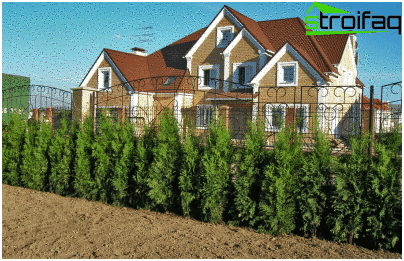
A freely growing hedge is less decorative, but the time it takes to maintain it is much lower
Green wall care
Experienced gardeners rarely have problems with planting shrubs, but when creating a natural hedge, several subtleties need to be considered.
- Green architecture requires clear shapes: to determine the boundaries, you need to use a taut rope, as well as to create clear contours of the upper edge with a planned cutting.
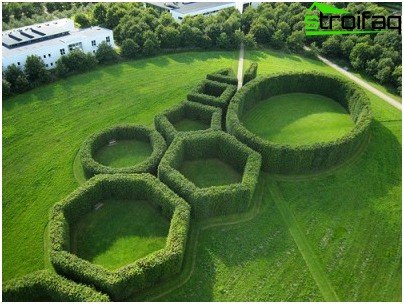
The key to spectacular green hedge – clarity of form
- When creating a multi-row multi-level planting, it is necessary to place higher plants in the far row.
- For a hedge planted along the outer borders of the garden, you need to choose trees that do not drop foliage so that in winter you do not remain without a visual curtain.
- The first pruning of bushes is carried out immediately after planting, otherwise the fence will not grow dense along the ground.
- The first 3-4 years of the fence set the shape, further care consists of watering, fertilizing, weeding and supporting mowing.


